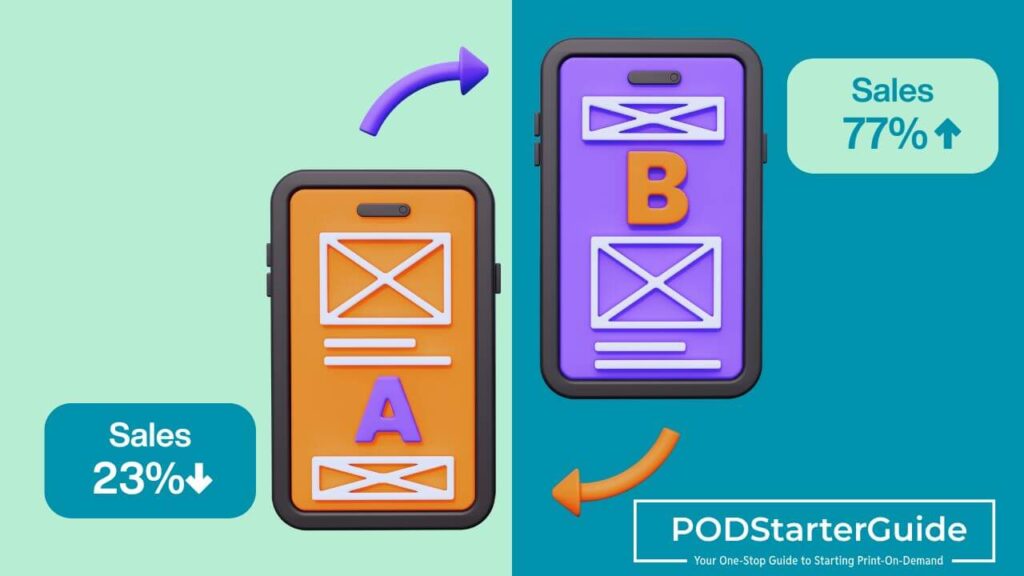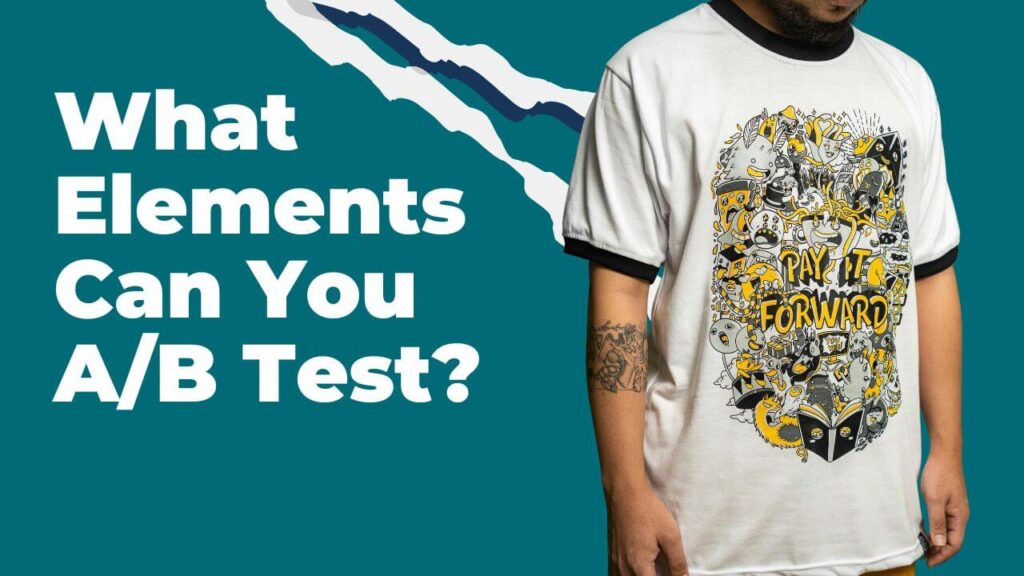A/B Testing in Print on Demand: What to Test and Why It Matters

Ever felt like you’ve done everything right in your Print on Demand (POD) business, but your designs still aren’t flying off the virtual shelves? That’s where A/B testing in print on demand really comes into play. It’s not just some fancy marketer’s trick—it’s literally how successful sellers figure out what works before spending too much time or money on it.
Let’s dive into the what, why, and how of A/B testing (without getting boring or too technical, promise).
What is A/B Testing and How Does it Work in the Print on Demand Business?
A/B testing, also called split testing, is a way experimenting what works and what doesn’t. You show two versions of something—say, two different product titles or two ad creatives—to different sets of users and see which one performs better.
In the world of print on demand, this could mean testing:
- Two versions of a t-shirt design
- Different product mockups
- Or even testing out two email subject lines for your store promo
The goal? Let the data tell you what’s working. Not your gut, not your assumptions—cold, honest results.
Why Should Print on Demand Sellers Care About A/B Testing?
Well, because guessing is expensive. Without A/B testing in print on demand, you’re Rolling the dice and hoping for a six. But here’s why it really matters:
- You save money. Test your ads before going all in.
- You learn faster. See what customers actually click on.
- You sell smarter. Know what they like, not just what you like.
When done right, split testing becomes your best friend. It reveals customer behavior, shows you where your shop is leaking conversions, and helps make more confident decisions.
What Elements Can You A/B Test in a Print on Demand Store?

This is where things get fun. There’s a whole world of possibilities when it comes to testing stuff in your POD shop—and honestly, some of the smallest tweaks can make a surprisingly big impact. Let’s break it down look into few key areas where A/B testing can seriously change the game.
Product Titles
Product titles are one of the first things your customer sees—so they deserve attention. You can A/B test titles that are fun and emotional vs. keyword-rich and descriptive to see what works better for your audience.
Let’s say you have a print on demand t-shirt that has the text “World’s Okayest Sister” printed on it.
You can title it in two different ways:
- Version A (Funny/Emotional): World’s Okayest Sister
This title plays on humor and might connect emotionally, especially for people buying gifts. - Version B (Keyword-Focused): Minimal Text Graphic Tee for Women
This one is packed with searchable keywords like “graphic tee,” “minimal,” and “for women,” which helps with visibility on search engines or marketplaces.
Why test this?
Because sometimes funny titles connect better with buyers emotionally, especially on social media. But keyword-rich titles might perform better in search results on platforms like Etsy, Amazon, or Google. It all depends on where your traffic is coming from and what your buyers respond to.
Product Descriptions
People don’t always read, but when they do—they care.
Try split testing:
- Bullet points vs. Storytelling: The first is clean and fast; the second builds emotion
- Feature-driven vs. benefit-driven: “100% cotton, machine washable” vs. “Soft enough to sleep in, durable enough to last wash after wash”
Tip: In many cases, benefit-driven copy outperforms techy specs. People don’t want a “220gsm shirt.” They want one that feels premium and doesn’t shrink like crazy.
Images & Mockups
This is a huge one. Visuals are everything in ecommerce—especially POD.
Test out:
- Flat lays vs. Lifestyle images: A clean studio shot vs. someone actually wearing the product
- Different models: Age, style, background all impact relatability
- Zoomed-in detail shots vs. full product views
Lifestyle photos generally win here—they help people imagine themselves using the product. Plus, lifestyle visuals can tell a mini-story at a glance. But in some niches (like techy or minimalistic brands), flat mockups might actually work better. Always test.
Pricing
Sounds scary, but yes—you can and should test your prices. Try:
- ₹599 vs. ₹649
- ₹999 vs. ₹1049 (odd vs. round pricing)
- Include or exclude “Free Shipping” messaging
Sometimes, the higher price performs better. Why? Because people associate price with value. Other times, shaving off ₹50 gets you 15% more conversions. The sweet spot varies a lot depending on your niche and customer mindset.
Calls to Action (CTAs)
That one little button can make or break a sale. You’d be surprised how powerful wording can be. Examples to test:
- “Buy Now” vs. “Get Yours Today”
- “Add to Cart” vs. “Snag This Before It’s Gone”
- “Shop Now” vs. “Claim This Offer”
Emotional, action-oriented CTAs often get more clicks than plain ones. But again, depends on your tone. A serious brand might do better with “Order Now,” while a quirky one might slay with “Snag It.”
Landing Pages
Sometimes it’s not what you’re selling—it’s where you send people. You could test:
- Your homepage vs. a direct product page
- A seasonal landing page (like “Best Father’s Day Gifts”) vs. a generic one
- Page layouts: Reviews at top vs. bottom, longer vs. shorter format
For paid traffic, sending people straight to the exact product (with minimal distractions) usually converts better. But for email subscribers or loyal followers, a more general page with options might increase average order value.
Which Product Designs Should You A/B Test and How to Choose Them?
Okay, you probably have dozens (maybe hundreds) of designs. So, which ones do you even test? Start with:
- Top sellers – They’re already working, but can they do better?
- New launches – See which versions gain traction faster.
- Seasonal variations – Holiday designs in two styles? Test both.
- Design tweaks – Slight change in color, font, or layout might make a huge difference.
Sometimes, the thing you think won’t work… ends up outperforming everything else. So test those “maybes” too.
How Do You Set Up an Effective A/B Test in Your POD Store or Ads?
Honestly, it’s not rocket science. You don’t even need a team.
Here’s a simple game plan:
- Pick what you want to test. One element at a time.
- Form a clear hypothesis. Example: “Using lifestyle images will boost clicks.”
- Use a tool. Shopify A/B testing apps or Meta Ads manager work well.
- Split your audience. Half sees Version A, the other sees Version B.
- Let it run. No peeking. Be patient for results.
Just don’t change too many things at once, or you won’t know what’s driving the change.
Also Read: How to Find the Perfect Niche for Your POD Store in 2025
What Metrics Should You Track During an A/B Test?
Metrics are your GPS during an A/B test. Without them, you’re just driving blind. Here’s what you need to keep an eye on:
- Click-Through Rate (CTR) – Are people clicking your ad or product?
- Conversion Rate – Do those clicks turn into purchases?
- Bounce Rate – Are they leaving too soon?
- Cart Abandonment Rate – Something wrong in checkout?
- Average Order Value – Which version brings in more ₹₹₹?
- Return on Ad Spend (ROAS) – For paid traffic, this one’s super important.
Numbers don’t lie. They’ll show you where the bottleneck is.
How Long Should You Run an A/B Test Before Making a Decision?
Here’s a little truth nobody tells you: Don’t jump to conclusions too early. A good test usually needs:
- At least 1-2 weeks
- Or 1,000+ visitors for better reliability
- Enough conversion events (not just views)
Don’t stop the test just because one version is winning on day two. Let the numbers settle. Patterns take time. Consumer behavior is unpredictable. Some days you might get a spike in traffic because of an Instagram post, others might be slow because of a holiday. If you cut the test too soon, you might mistake a temporary blip for a true pattern. That could lead you to pick the wrong winner—and actually lose sales.
Watch out for:
Random fluctuations. Early results often look extreme—don’t get fooled.
External factors. Maybe your test launched the same day as a big sale. Or your site had downtime. All of that can skew data.
No clear winner? If both versions are performing about the same even after a decent sample size and timeframe, that’s still useful. You now know both work—and can move on to testing something else.
What Are Common Mistakes to Avoid While A/B Testing in POD?
Watch out for these so you don’t waste time or skew your results.
- Testing too many variables at once – You won’t know what caused the change.
- Ending tests too early – Patience is key.
- Not using a large enough sample size – Small traffic = unreliable data.
- Ignoring context – Maybe it was a holiday weekend, maybe your site was glitchy.
- No clear hypothesis – “Let’s test random stuff” doesn’t count.
A/B testing in print on demand: what to test and why it matters is all about method, not madness.
How Can You Use A/B Testing Results to Grow Your POD Business?
Now here’s the part where you take your test results and actually do something with them. You can:
- Double down on what’s working—run more ads, make more variants, feature it prominently.
- Fix leaks—use insights to improve bad performing listings.
- Test iteratively—take the winner and test a new variation of it.
- Improve UX—make checkout easier based on what users interact with.
It’s not just about one win. It’s about building momentum through insights
Is A/B Testing a One-Time Thing or an Ongoing Process?
Let’s be real—nothing in ecommerce is static. Consumer tastes shift, seasons change, and trends evolve faster than we can blink. That’s why A/B testing in print on demand isn’t a one-and-done thing. It’s a process. A habit.
You might test a product page layout in January and need to revisit it in April. Or an ad creative might work well today but flop next month. Keep testing, keep learning, and keep adjusting. That’s how stores grow from okay to legendary.
Conclusion: How Can You Start A/B Testing Today?
If you’ve made it this far—awesome. You’re already ahead of most sellers. Getting started is easy:
- Pick one thing to test this week.
- Set up your versions (use Shopify apps, Facebook ad splits).
- Track your results without rushing the decision.
- Then repeat with a new variable next time.
Remember, A/B testing in print on demand: what to test and why it matters isn’t about being perfect. It’s about being curious. You’re not chasing perfection—you’re uncovering what works better.